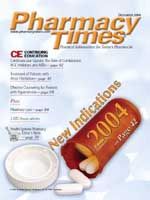Publication
Article
Pharmacy Times
Counterfeit Drugs: A Real Cause for Alarm
Author(s):
The media, health care professionals, and consumers are fascinated with the worldwide counterfeit drug problem. In 1999, Thailand's Ministry of Public Health found that approximately 60% of 133 drug vendors in Cambodia sold antimalarial medications lacking the purported active ingredient.1 In May 2002, counterfeiters made a $28-million profit from a shipment of 11,000 boxes of counterfeit Epogen and Procrit that contained primarily Miami (Florida) tap water. In the spring of 2003, patients complained about Lipitor tablets tasting unusually bitter and causing a burning sensation, and looking larger than the ones from their previous prescriptions. In addition, in February 2004 the FDA determined that transdermal contraceptive patches (Ortho-Evra) sold on certain international Web sites contained no active ingredient.2 The availability of counterfeit drugs is increasing dramatically, and, in response, pharmacists must be aware of the potential for danger.
Definition
The World Heath Organization (WHO) defines counterfeit drugs as "deliberately and fraudulently mislabeled with respect to identity and/or source. Counterfeiting can apply to both branded and generic products. Counterfeit products may include products with the correct ingredients or with the wrong ingredients, without active ingredients, with insufficient active ingredients, or with fake packaging." Products typically considered counterfeit include look-alike products with little or no active ingredient or containing harmful ingredients; drug products previously rejected and kept off the market; and medications that have expired but have been relabeled or repackaged with later expiration dates.1
On 2 levels, counterfeit drugs have potential for consumer harm: the individual level and the societal level. Consumption of adulterated substances or lack of treatment can harm an individual. The range of consequences from inadvertently ingesting an unknown substance is clear: from unexpected adverse reactions to toxicity to anaphylaxis. Yet, taking phony "medications" can be equally life-threatening: inert antibiotics will not cure infectious disease, nor will "vaccination" with a counterfeit vaccine protect one from illness. Improper treatments risk public health, either through increased disease transmission or through the development of antibiotic resistance.1
Whereas counterfeit drugs pose an obvious risk for the patient, they also impact manufacturers. Counterfeit products prompt time-consuming, expensive, massive recalls and mandate labeling and packaging changes to ensure that patients receive safe and accurate products.2
Prevalence
Global counterfeit drug prevalence, while elusive, is spreading rapidly. Historically, experts considered counterfeiting exclusive to developing countries in Southeast Asia, Africa, and South America. Reports from these areas suggest that 10% to 50% of drugs in certain countries may be counterfeit. In fact, India's counterfeit rate is so high that the Indian Parliament is expected to pass the death penalty for individuals found guilty of counterfeiting.2
Increased free trade and on-line pharmacies, however, have facilitated worldwide counterfeiting operations.1 Although the FDA does not acknowledge that counterfeit drugs are extensive in the United States, it acknowledges a significant increase in incidence.1 FDA counterfeit investigations in the United States quadrupled from 5 annually in the 1990s to 20 annually in 2000, identifying an estimated less than 1% counterfeit prescriptions.2 With US prescription sales exceeding 1 billion pills annually, the raw number of counterfeit drugs is startling. Popular counterfeit targets usually are high-volume and high-cost drugs?especially injectable solutions, HIV and AIDS treatments, and psychiatric medications.2
How have counterfeit drugs slipped into society? Some counterfeit activity results from fractures in the manufacturer- to-consumer chain. Usually drugs are distributed from manufacturers to wholesalers, which then distribute the drugs to retail or hospital facilities. Occasionally, however, wholesalers will distribute drugs to other wholesalers or repackaging organizations. These additional links in the drug-supply process allow opportunities to incorporate counterfeit drugs.2
Internet pharmacies are another significant source for counterfeit drugs. The convenience and privacy of on-line pharmacies?especially for those who are sick, disabled, or less likely to leave their homes?is wonderful when it is legitimate. Disreputable Web sites, however, also sell counterfeit or unapproved drugs. Unfortunately, differentiating reliable from unreliable products challenges consumers and governing bodies.3
Working Toward a Solution
Counterfeit drugs are a persistent problem. The 1988 WHO Conference of Experts on the Rational Use of Drugs gave priority to counterfeit prevention. Yet, nearly 20 years later counterfeiting prevails.1 What actions are being taken to prevent it?
The Prescription Drug Marketing Act was signed into law in 1988 and amended in 1992. Its requirements are twofold. First, wholesalers that are not "manufacturer-authorized distributors" must provide a pedigree to prove drug authenticity.2 This provision originally was scheduled for implementation in December 2000, but the deadline has been extended to December 2006.3
The second half of the Prescription Drug Marketing Act requires state wholesaler licensure.2 Difficulties in enforcing the act have resulted from minimal licensure requirements, few inspections, and a longstanding history of informal contracts with wholesalers and businesses.2
More recently, the FDA developed a Counterfeit Drug Task Force to identify weaknesses in the US drug-distribution process. Its goal is "preventing the introduction of counterfeit drugs, facilitating the identification of counterfeit drugs, minimizing risk and exposure of consumers to counterfeit drugs, and avoiding the addition of unnecessary costs on the prescription drug distribution system, or unnecessary restrictions to lower-cost sources of drugs." Task force strategies to combat counterfeit drugs include advancing technology, securing business and regulatory requirements, educating stakeholders, increasing public awareness, addressing international issues, and developing rapid alert and response systems.1
The National Association of Boards of Pharmacy (NABP) recently approved revisions to its Model Rules on the Licensure of Wholesale Distributors. The changes mimic Florida and Nevada state regulations. They include stringent licensing, requiring background checks and extensive disclosure; track-and-trace technologies; electronic pedigrees by 2007; and tougher violation penalties. NABP also released a susceptible drug-product list that identifies products at increased risk for adulteration, counterfeiting, or diverting (Table).4,5
Globally, WHO has established an overview of drug counterfeiting and preventive means. The 1999 Guidelines for the Development of Measures to Combat Counterfeit Drugs identifies weaknesses in the pharmaceutical distribution system that present counterfeit opportunities.1,6
On the Horizon
Advancing technology may efficiently prevent the circulation of counterfeit drugs. "Track and trace" is a system requiring manufacturers to attach a radio frequency identification tag with a unique electronic serial number to each drug bottle. This system allows product tracing throughout the chain of distribution to dispensing. Other benefits of electronic tagging include improved inventory control, easier recall, and safer dispensing.2
The University of Maryland School of Pharmacy has proposed Near-Infrared (NIR) Spectroscopy to detect counterfeit drugs. NIR scans each tablet or capsule to reveal the drug's unique pattern of light, or "fingerprint." Each fingerprint can then be cross-referenced with a database. If the scanned fingerprint does not match the one on file, pharmacists will know immediately that the drug is counterfeit. The FDA is evaluating NIR's preventive role.7
Myriad factors influence the rising rate of counterfeit drugs. Pharmacists can intercept the distribution of these drugs to the patient, thereby preventing harm. Heightened awareness and perception will be key in stopping the chain of counterfeit drugs.
Dr. Holmberg is a pharmacist with Phoenix Indian Medical Center, Phoenix, Ariz. The opinions expressed are those of the author and not necessarily of any government agency.
For a list of references, send a stamped, self-addressed envelope to: References Department, Attn. A. Stahl, Pharmacy Times, 241 Forsgate Drive, Jamesburg, NJ 08831; or send an e-mail request to: [email protected].

Newsletter
Stay informed on drug updates, treatment guidelines, and pharmacy practice trends—subscribe to Pharmacy Times for weekly clinical insights.






